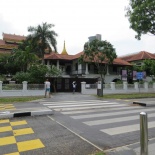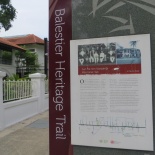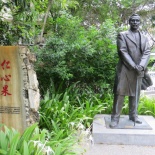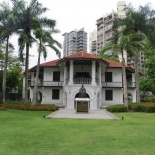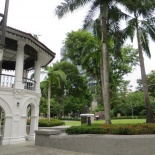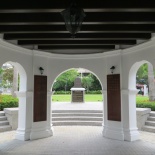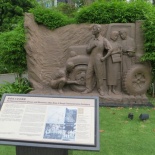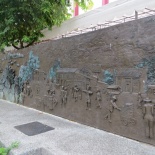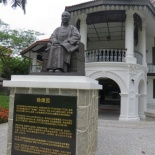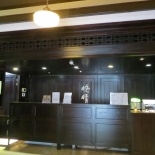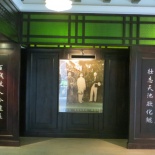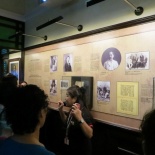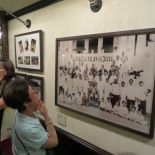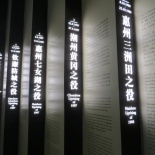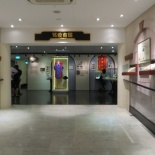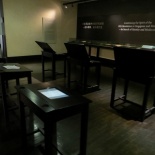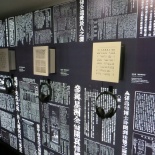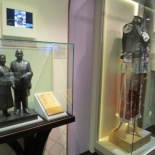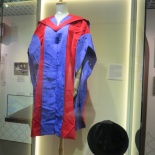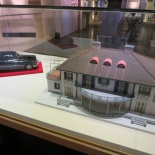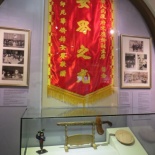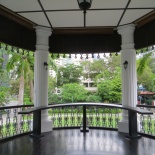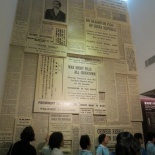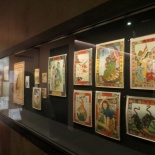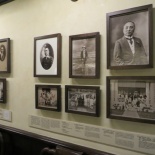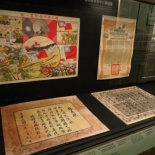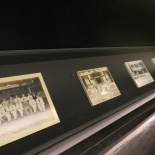I recently had a chance to visit some of the lesser well-known gems around Singapore. The Sun Yat Sen Nanyang Memorial Hall (SYSNMH) is a historical colonial style villa located at 12 Tai Gin Road, Singapore. The memorial is essentially a converted 2 storey villa located in Balestier off Ah Hood Road right opposite Zhongshan Park. The villa is now a museum commemorating Sun Yat-sen, the founding father of the Republic of China and his stays in Singapore from 1900 to 1911.
The National Heritage Board which runs the place offers free admission for Singaporeans & Permanent Residents ($2 – $4 for Tourist & Foreign Citizens) and is open Tuesday to Sundays from 10am to 5pm.
The villa played important roles in the 1911 Xinhai Revolution by serving as the Tongmenghui’s base in Nanyang (Southeast Asia) in the early 20th century. It is over a century old, it was designed in 1900, built in 1901 by a businessman named Boey Chuan Poh.It was constructed in a classical colonial style, named the Bin Chan House (a racehorse that Boey owned), featuring ornate arched windows and doors, eaves decorated with floral patterns, and movable louvered windows to the architecture in those yesteryears. However, it was not long where the house was sold in 1902 to Lim Ah Liang and subsequently to rubber magnate Teo Eng Hock (great-granduncle of Teo Chee Hean) in 1905 for his mother, Tan Poh Neo, as a place of retirement. The villa was renamed to Wan Qing Yuan.
In 1906, when Sun returned to Singapore, Teo, who knew Sun Yat-sen through his close friend, Yau Li offered Wan Qing Yuan for use as the Tongmenghui’s headquarters in Southeast Asia. Wan Qing Yuan also became the planning centre for fund-raising and the following uprisings activities leading to the 1911 Xinhai Revolution:
- Chaozhou Uprising (May 1907)
- Zhennanguan Uprising (December 1907)
- Hekou Uprising (April 1908)
Changing of hands and refurbishment
Teo Eng Hock sold the villa in August 1910. In 1937 it was bought by a group of six leading Chinese businessmen (Lee Kong Chian, Tan Ean Kiam, Lee Chin Tian, Chew Hean Swee, Lee Chor Seng and Yeo Kiat Tiow), whom in that following year, donated the villa to the Singapore Chinese Chamber of Commerce and Industry (SCCCI). After the establishment of the Republic of China, the Chinese Nationalist Government funded the Villa refurbishment, turning it into a Memorial Hall complete with artifacts related to Sun Yat-sen from overseas Chinese communities and opened it to the public in 1940.
The villa survived the Second World War. However, the Japanese occupation (1942–1945) saw the villa used as Japanese military communication base, resulting in the destruction of many original artifacts and furniture. The Nationalist Government funded the 1949 villa restoration after the war, setting up the Kuomintang’s Singapore branch within- a move prohibited by Singapore colonial government. As such, the villa returned hands back to the SCCCI in 1951and renamed to Sun Yat Sen Villa after 1964 renovation, and subsequently the Sun Yat Sen Nanyang Memorial as a National Monument on 28 October 1994 by the Singapore government. The villa was converted into a museum in 2001 and managed by the National Heritage Board 2009. The museum reopened on 8 October 2011 after incremental renovations to commemorate the centenary of the Xinhai Revolution.
Displays
Upon entering the 3,120 sq meter villa compound, you will be greeted by several bronze statues of people scattered around the garden who helped Sun Yat-sen in the Xinhai Revolution. Lined along the villa compound walls are bronze wall murals sculpted by artists from China, made from a 6 year period between 1999 and early 2005, depicting Singapore’s history and scenes of Singapore as a fishing village from the 1840s to the 1940s. It spans 60 metres and made at a cost of S$1 million. At the centre of the compound in front of the villa is a one-metre tall sculpture of Sun Yat-sen himself seated on a chair, presented by the Chinese government in 1937.
More bronze sculptures of Yat-sen lines the hallway leading to the museum’s glass door entrance and reception area. The museum does guided tours in Chinese twice daily conducted by volunteers (see reception for timings).
The 2 storey villa itself now is an air-conditioned museum, lined with nicely panel dark rosewood walls. Items displayed on first floor include portraits, picture, books, literature and personal items tracing Dr Sun’s revolutionary activities in the Southeast Asian. The displays also highlights Memorial Hall features a storyline and galleries highlighting Nanyang as a base for the 1911 Chinese Revolution; and explores the impact and Singapore’s contributions to the Revolution by the Singapore Chinese community. It also introduces key community leaders in the early 20th century, such as Lim Nee Soon, Eng Hock and Tan Chor Nam. The displays are portrayed through a combination of print and audio-visual elements depicting words of wisdom and lines of poetry.
Notable works includes Chinese calligraphy, and one bearing the Chinese characters 博愛 (Universal love) presented to Sun Yat-sen by Teo Beng Wan (Teo Eng Hock’s nephew) and a Seal belonging to Tan Chor Lam, engraved with the Chinese characters 結愛國緣 (Love for country and fellow countrymen). An annex connected at the rear of the house extends the exhibition space with models and period-era clothing worn by the people of the yester-years.
On display too is a book based on the recollection by Tan Chor Lam (1940s), containing records of the Tongmenghui’s activities in Singapore and a Memoir by Teo Eng Hock (Nanyang and the Founding of the Republic), providing a detailed record of the Tongmenghui’s activities in Southeast Asia. The stairways to the second floor halls are pretty narrow and are not wheelchair accessible.
Lined along the walls on the second floor are photographs of Yat-sen himself and members of the Tongmenghui’s Singapore branch, taken at Wan Qing Yuan around 1906, including oil and watercolour paintings and calligraphy works by various Singaporean/Chinese artists (e.g. Liu Kang, Buddhist monk and the Reverend Song Nian) as well as cultural Medallion-winning artists Ong Kim Seng and Tan Swie Hian.
You can easily run through all the exhibits under 3 hours, perfect for a good for a good half-day family event, and relaxing with a good assortment of food places around the Balestier area after your visit. It’s always nice to see small little gems like this still around in urban Singapore, worth a good day out to appreciate the country’s past.
View more photos of the museum here.

